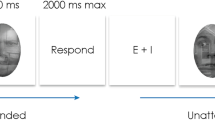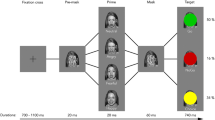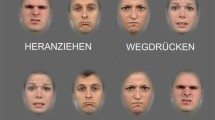Abstract
We conducted two studies (Ns=52 and 60) to test the notion that the incentive salience of facial expressions of emotion (FEE) is a joint function of perceivers’ implicit needs for power and affiliation and the FEE’s meaning as a dominance or affiliation signal. We used a variant of the dot-probe task (Mogg & Bradley, 1999a) to measure attentional orienting. Joy, anger, surprise, and neutral FEEs were presented for 12, 116, and 231 ms with backward masking. Implicit motives were assessed with a Picture Story Exercise. We found that power-motivated individuals orient their attention towards faces signaling low dominance, but away from faces that signal high dominance, and (b) that affiliation-motivated individuals show vigilance for faces signaling low affiliation (rejection) and, to a lesser extent, orient attention towards faces signaling high affiliation (acceptance).
Similar content being viewed by others
References
Adams, R. B., Jr., Gordon, H. L., Baird, A. A., Ambady, N., & Kleck, R. E. (2003). Effects of gaze on amygdala sensitivity to anger and fear faces. Science, 300(5625), 1536.
Adolphs, R. (2002). Recognizing emotion from facial expressions: Psychological and neurological mechanisms. Behavioral and Cognitive Neuroscience Reviews, 1, 21–61.
Atkinson, J. W. (1957). Motivational determinants of risk-taking behavior. Psychological Review, 64, 359–372.
Atkinson, J. W., & Walker, E. L. (1958). The affiliation motive and perceptual sensitivity to faces. In J. W. Atkinson (Ed.), Motives in fantasy, action, and society: A method of assessment and study (pp. 360–366). Princeton, NJ: Van Nostrand.
Battistich, V. A., & Aronoff, J. (1985). Perceiver, target, and situational influences on social cognition: An interactional analysis. Journal of Personality and Social Psychology, 49, 788–798.
Biehl, M., Matsumoto, D., Ekman, P., Hearn, V., Heider, K., Kudoh, T., et al. (1997). Matsumoto and Ekman’s Japanese and Caucasian facial expressions of emotion (JACFEE): Reliability data and cross-national differences. Journal of Nonverbal Behavior, 21, 3–21.
Boyatzis, R. E. (1973). Affiliation motivation. In D. C. McClelland, & R. S. Steele (Eds.), Human motivation—a book of readings (pp. 252–276). Morristown, NJ: General Learning Corporation.
Derryberry, D., & Reed, M. A. (1994). Temperament and attention: Orienting toward and away from positive and negative signals. Journal of Personality and Social Psychology, 66(6), 1128–1139.
Field, M., Mogg, K., & Bradley, B. P. (2004). Eye movements to smoking-related cues: Effects of nicotine deprivation. Psychopharmacology (Berl), 173(1–2), 116–123.
Hess, U., Blairy, S., & Kleck, R. E. (2000). The influence of facial emotion displays, gender, and ethnicity on judgments of dominance and affiliation. Journal of Nonverbal Behavior, 24, 265–283.
Kiesler, D. J. (1983). The 1982 interpersonal circle: A taxonomy for complementarity in human transactions. Psychological Review, 90, 185–214.
Klinger, E. (1967). Modeling effects on achievement imagery. Journal of Personality and Social Psychology, 7, 49–62.
Knutson, B. (1996). Facial expressions of emotion influence interpersonal trait inferences. Journal of Nonverbal Behavior, 20, 165–182.
Koestner, R., & McClelland, D. C. (1992). The affiliation motive. In C. P. Smith (Ed.), Motivation and personality: Handbook of thematic content analysis (pp. 205–210). New York: Cambridge University Press.
Koster, E. H., Crombez, G., Verschuere, B., & De Houwer, J. (2004). Selective attention to threat in the dot probe paradigm: Differentiating vigilance and difficulty to disengage. Behaviour Research and Therapy, 42(10), 1183–1192.
MacLeod, C., Mathews, A., & Tata, P. (1986). Attentional bias in emotional disorders. Journal of Abnormal Psychology, 95, 15–20.
Matsumoto, D., & Ekman, P. (1988). Japanese and Caucasian facial expressions of emotion (JACFEE) and neutral faces (JACNeuF) [Slides]. San Francisco: Author.
Mazurski, E. J., Bond, N. W., Siddle, D. A., & Lovibond, P. F. (1996). Conditioning with facial expressions of emotion: Effects of CS sex and age. Psychophysiology, 33(4), 416–425.
McAdams, D. P. (1992). The intimacy motive. In C. P. Smith (Ed.), Motivation and personality: Handbook of thematic content analysis (pp. 224–228). New York: Cambridge University Press.
McClelland, D. C. (1980). Motive dispositions. The merits of operant and respondent measures. In L. Wheeler (Ed.), Review of personality and social psychology (Vol. 1, pp. 10–41). Beverly Hills, CA: Sage.
McClelland, D. C. (1987). Human motivation. New York: Cambridge University Press.
McClelland, D. C., Koestner, R., & Weinberger, J. (1989). How do self-attributed and implicit motives differ? Psychological Review, 96, 690–702.
McClelland, D. C., & Liberman, A. M. (1949). The effect of need for achievement on recognition of need-related words. Journal of Personality, 18, 236–251.
Mogg, K., & Bradley, B. P. (1999). Selective attention and anxiety: A cognitive-motivational perspective. In T. Dalgleish & M. Power (Eds.), Handbook of cognition and emotion (pp. 145–170). Chichester: Wiley.
Mogg, K., & Bradley, B. P. (1999). Some methodological issues in assessing attentional biases for threatening faces in anxiety: A replication study using a modified version of the probe detection task. Behaviour Research and Therapy, 37, 595–604.
Pang, J. S., & Schultheiss, O. C. (2005). Assessing implicit motives in U.S. college students: Effects of picture type and position, gender and ethnicity, and cross-cultural comparisons. Journal of Personality Assessment, 85(3), 280–294.
Schultheiss, O. C. (in press). Implicit motives. In O. P. John, R. W. Robins, & L. A. Pervin (Eds.), Handbook of personality: Theory and research (3rd ed.). New York: Guilford.
Schultheiss, O. C., Pang, J. S., Torges, C. M., Wirth, M. M., & Treynor, W. (2005). Perceived facial expressions of emotion as motivational incentives: Evidence from a differential implicit learning paradigm. Emotion, 5(1), 41–54.
Smith, C. P. (Ed.). (1992). Motivation and personality: Handbook of thematic content analysis. New York: Cambridge University Press.
Smuts, B. B. (1985). Sex and friendship in baboons. New York: De Gruyter.
Spangler, W. D. (1992). Validity of questionnaire and TAT measures of need for achievement: Two meta-analyses. Psychological Bulletin, 112, 140–154.
Veroff, J., & Veroff, J. B. (1972). Reconsideration of a measure of power motivation. Psychological Bulletin, 78, 279–291.
Williams, J. M. G., Mathews, A., & MacLeod, C. (1996). The emotional Stroop task and psychopathology. Psychological Bulletin, 120, 3–24.
Wilson, E., & MacLeod, C. (2003). Contrasting two accounts of anxiety-linked attentional bias: Selective attention to varying levels of stimulus threat intensity. Journal of Abnormal Psychology, 112(2), 212–218.
Winter, D. G. (1973). The power motive. New York: Free Press.
Winter, D. G. (1994). Manual for scoring motive imagery in running text, (4 ed.). Department of Psychology, University of Michigan, Ann Arbor: Unpublished manuscript.
Acknowledgments
This research was supported by a Horace H. Rackham School of Graduate Studies Faculty Grant and NSF grant BCS 0444301 to Oliver C. Schultheiss. We are grateful to Scott Liening for serving as a second PSE coder in both studies. Scatterplot graphs with fitted regression lines illustrating the main findings of both studies can be obtained from the first author.
Author information
Authors and Affiliations
Corresponding author
Rights and permissions
About this article
Cite this article
Schultheiss, O.C., Hale, J.A. Implicit Motives Modulate Attentional Orienting to Facial Expressions of Emotion. Motiv Emot 31, 13–24 (2007). https://doi.org/10.1007/s11031-006-9042-9
Received:
Accepted:
Published:
Issue Date:
DOI: https://doi.org/10.1007/s11031-006-9042-9




